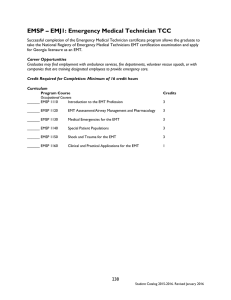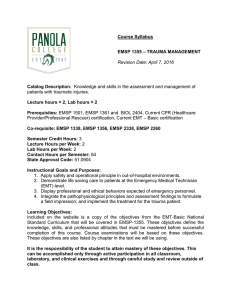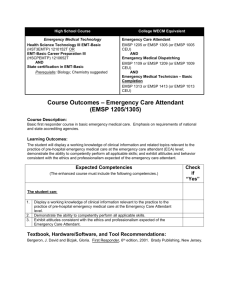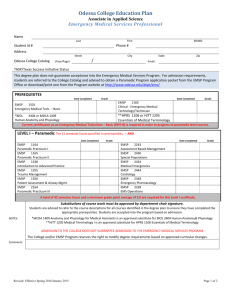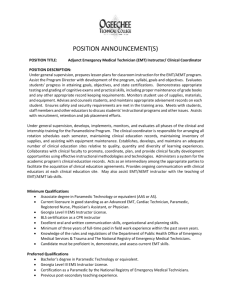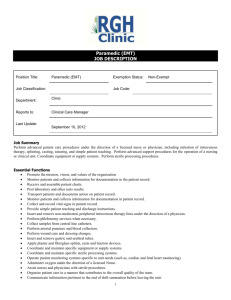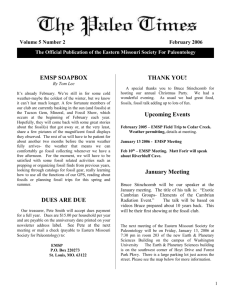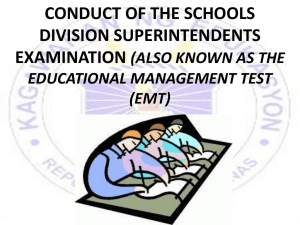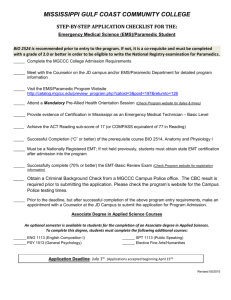10. Pathway Alignment Plan - Example
advertisement
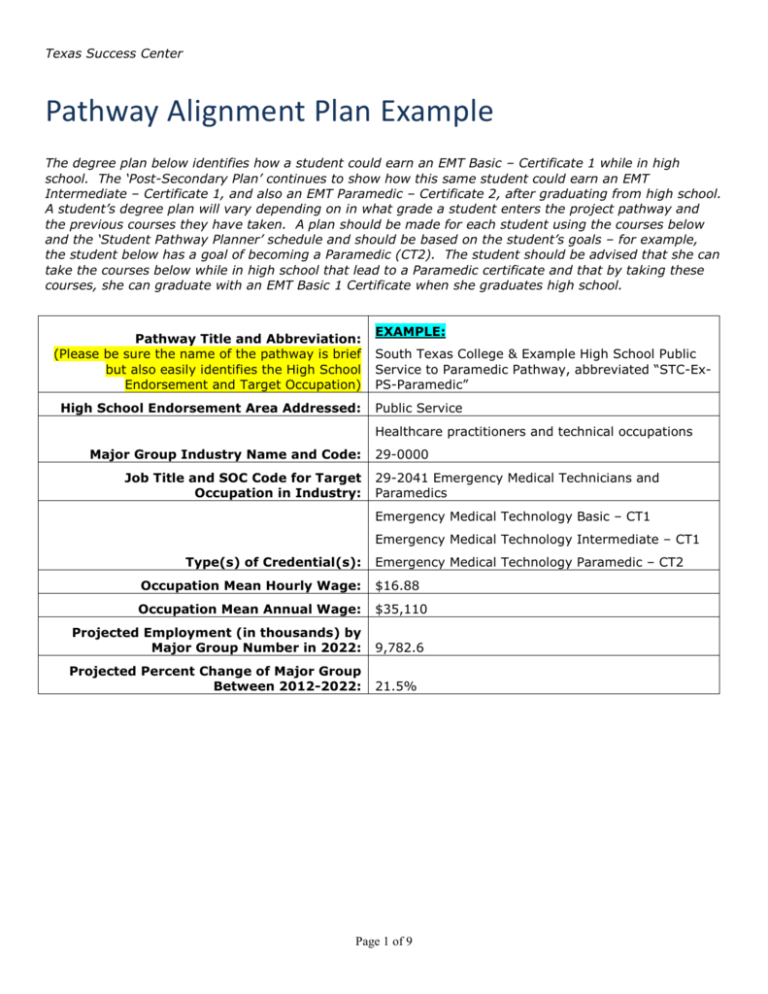
Texas Success Center Pathway Alignment Plan Example The degree plan below identifies how a student could earn an EMT Basic – Certificate 1 while in high school. The ‘Post-Secondary Plan’ continues to show how this same student could earn an EMT Intermediate – Certificate 1, and also an EMT Paramedic – Certificate 2, after graduating from high school. A student’s degree plan will vary depending on in what grade a student enters the project pathway and the previous courses they have taken. A plan should be made for each student using the courses below and the ‘Student Pathway Planner’ schedule and should be based on the student’s goals – for example, the student below has a goal of becoming a Paramedic (CT2). The student should be advised that she can take the courses below while in high school that lead to a Paramedic certificate and that by taking these courses, she can graduate with an EMT Basic 1 Certificate when she graduates high school. Pathway Title and Abbreviation: (Please be sure the name of the pathway is brief but also easily identifies the High School Endorsement and Target Occupation) High School Endorsement Area Addressed: EXAMPLE: South Texas College & Example High School Public Service to Paramedic Pathway, abbreviated “STC-ExPS-Paramedic” Public Service Healthcare practitioners and technical occupations Major Group Industry Name and Code: Job Title and SOC Code for Target Occupation in Industry: 29-0000 29-2041 Emergency Medical Technicians and Paramedics Emergency Medical Technology Basic – CT1 Emergency Medical Technology Intermediate – CT1 Type(s) of Credential(s): Emergency Medical Technology Paramedic – CT2 Occupation Mean Hourly Wage: $16.88 Occupation Mean Annual Wage: $35,110 Projected Employment (in thousands) by Major Group Number in 2022: 9,782.6 Projected Percent Change of Major Group Between 2012-2022: 21.5% Page 1 of 9 High School Course Name High School Credits 9 English I 1 9 Algebra I 1 9 Biology 1 9 World Geography 1 9 Basketball 1 9 Art I 1 9 Spanish I 1 Year/ Grade Level PEIMS Course # TCCNS # College Course Name College Semester Credit Hours Dual Credit Course Type *** 8 8 8 Total Year 0 Grade 8 Total Year 1 Grade 9 7 10 English II 1 10 Geometry 1 10 US History 1 10 Basketball 1 10 Spanish II 1 10 PS Endorse .5 EMSP 1160 EMT Basic Clinical 1 CTE 10 PS Endorse .5 EMSP 1166 EMT Basic Practicum 1 CTE Total Year 2 Grade 10 7 11 English III 1 11 Algebra II 1 11 Chemistry 1 11 Governme nt / 1 3 Page 2 of 9 Economics 11 Basketball 1 11 PS Endorse .5 EMSP 1208 Em Veh Ops 2 11 PS Endorse 1 EMSP 1371 EMS Doc 3 Total Year 3 Grade 11 6.5 5 12 English IV 1 12 Statistics 1 MATH 1442 Statistical Reasoning 3 Academic 12 Anatomy & Physiology 1 BIOL 2401 Anatomy & Physiology 4 Academic 12 Basketball 1 12 PS Endorse 1 EMSP 1472 Emergent Issues EMT 4 CTE 12 PS Endorse 1 EMP 1501 EMT 5 CTE Total Year 4 Grade 12 6 16 Degree Plan Total 26.5 24 (In this example, the student finishes high school with a Public Service Endorsement Degree, an EMT Basic 1 Certificate, and an additional 7 hours of academic dual credit coursework – 4 (Anatomy & Physiology) that are included in the degree plan to earn a Paramedic Level 2 Degree, and 3 (Statistical Reasoning) that can be applied to an Academic Degree leading to a BA or BS in multiple fields.) Post-Secondary Plan: 2018 Spring TCCNS # College Course Name Summer College Semeste r Credit Hours TCCNS # College Course Name EMSP 1161 EMT Int Hosp Cln EMSP 1167 EMSI EMTI Page 3 of 9 Fall College Semeste r Credit Hours College Semeste r Credit Hours TCCNS # College Course Name 1 EMSP 1355 Trauma Mngt 3 1 EMSP 1356 Patient Assess / 3 Prac EMSP 1338 Intro to AP Air Mngt 3 (In this example, the student graduates from high school in Spring 2018, then finishes enough courses at the end of Fall 2018 to earn an EMT Intermediate 1 Certificate) 2019 Spring TCCNS # College Course Name BIOL 2402 Anatomy & Phys II EMSP 2143 EMSP 2205 Summer College Semeste r Credit Hours Fall College Semeste r Credit Hours TCCNS # College Course Name 4 EMSP 2160 Para Clin I 1 Assess Based Mngt 1 EMSP 2166 CAP Para Prac 1 EMS Ops 2 EMSP 2330 Spec Pop 3 EMSP 2434 Med Emer 4 TCCNS # College Course Name College Semeste r Credit Hours (In this example, the student takes Anatomy & Physiology II, because she already has received dual credit for Anatomy and Physiology I while in high school. At the end of Summer 2019, the graduates with an EMT Paramedic Level 2 Degree) Courses Required for Pathways For each pathway, list all courses required for each credential and/or degree (can be cut and paste from web, see examples on next pages): Page 4 of 9 Page 5 of 9 Page 6 of 9 Page 7 of 9 Page 8 of 9 Additional Courses Required for Associate and/or Bachelor Degrees in a ‘Health Care Practitioners and Technical Operations’ Industry or General Degree Although not a requirement for this grant, advisers may want to include additional course information on pathways that lead to Associates and/or Bachelor/Applied Bachelors Degree for students, even if the Institution of Higher Education is not a partner through this grant program. An example of a Texas State University degree plan outline is provided below: Texas State University, College of Applied Arts, Department of Occupational, Workforce, and Leadership Studies, Bachelor of Applied Arts and Sciences (http://www.owls.txstate.edu/undergraduatedegrees/degree-planning.html) Six Modules Courses or Equivalents Total Hours General Education Core Curriculum Communication, Math, Life/Physical Science, Language, History, Social/Behavioral Science, Etc. 42 Occupational Emphasis Credit for your Certificate I and II, and for work experience (up to 41 hours approximately) and Occupational Required Courses at TSU :CTE 3313E, OCED 4350, and OCED. 48 Professional Development To individualize your degree 21 Practicum TSU Courses OCED 4360, OCED 4361 6 Electives Courses needed to complete 120 hours for degree 3 TOTAL: Page 9 of 9 120
